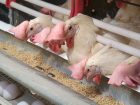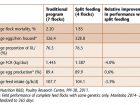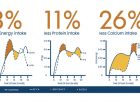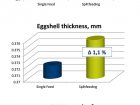
Precision layer feeding
By Greg Page Ph.D.
Features Nutrition and Feed Research NutritionSplit feeding program increases profits and sustainability.
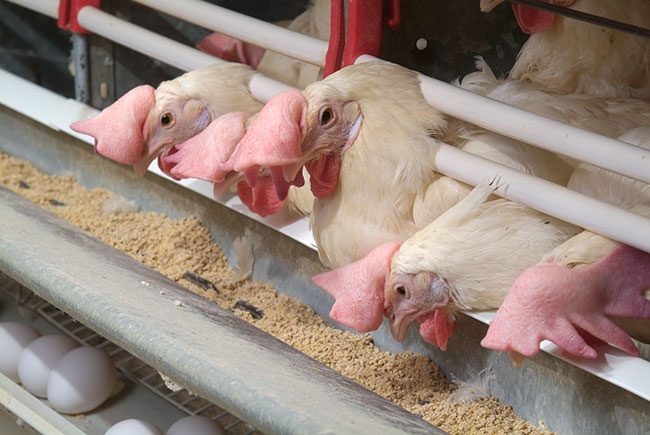 A new feeding approach provides nutritionally tailored separate morning and afternoon diets to hens.
A new feeding approach provides nutritionally tailored separate morning and afternoon diets to hens. Laying hen nutrition, while relatively complex, has seen little major innovation in the past 20 years or more. The majority of new developments have largely been refinements to precision on nutrient levels in response to differing production systems (e.g., cages versus aviary/free-run) or to specialty eggs (e.g., omega-3 enrichment). However, an innovative new split feeding program bucks this trend.
Split feeding is a novel precision nutrition alternative feeding program for layers. It provides nutritionally tailored separate morning and afternoon diets to the hens that respond to the bird’s natural physiological feeding behaviour and nutrient intake in relation to the different requirements throughout the day. This results in numerous benefits including cost savings, greater profits and increased egg quality, in addition to enhanced sustainability as a result of improved nutrient efficiency.
Laying hens lay the majority of their eggs during the morning, with the interval between two successive ovipositions being about 24 hours or slightly greater. The hen’s requirements for amino acids, energy, calcium and phosphorous do not remain constant, but vary throughout the day in accordance with their physiological needs for the formation of the various components of the egg.
Literature evidence from over 40 years ago suggests that when birds are offered diets that allow self-selection of nutrients, intakes of protein, energy and calcium were found to vary around the phase of egg component production (see figure 1). As a result, animals may consume fewer nutrients when they were able to choose the nutrients throughout the day using a two-feed approach relative to a single complete feed.
This suggests that the hen is using the energy, amino acids, calcium and phosphorous more efficiently by consuming these nutrients at moments in the day when the requirements are higher. This evidence questions the standard practice of providing hens with only one diet, as it indicates it might not be the ideal approach for optimal utilization of nutrients.
The development of a new laying hen feeding program in 2005 was designed to feed hens according to the specific nutrient requirement for egg formation that varies throughout the day. The findings of this research resulted in the development of the split feeding program, where two diets are used to meet the dynamic requirements for egg formation.
The morning diet is designed to meet requirements during albumen production/deposition, and the ovulation and oviposition occur. The afternoon diet is designed to meet requirements for eggshell formation. As a result of extensive research, new requirements for energy, amino acids, calcium and phosphorous were obtained for the morning and afternoon diets. While the total intake of these nutrients can be reduced, performance was maintained relative to when a single feed is fed (see table 1). In addition, researchers observed a number of additional benefits, including improved eggshell quality (see figure 2).
After the successful launch of the split feeding program, field performance data was collected from flocks using complete feed to validate research. The table below shows the overall results of flocks with the same Lohman LSL white genetics in Manitoba from 2014 to 2015:
While the nutritional elements of the feeding program are a significant factor to the success of split feeding, it should be noted that it might not be suitable for all production situations. Management factors play a significant role, as not all facilities can be successfully adapted to accommodate the unique requirements of the feeding program (feed allocations, equipment limitations). In addition, the scale of the operation plays a factor, as there are additional infrastructure needs (e.g., second bin, control systems, scales) that affect the economic benefits of the program.
As Trouw Nutrition is committed to improving the sustainability of the agricultural sector, it completed a life-cycle assessment (LCA) of the split feeding system to assess the environmental impacts of this novel feeding strategy. Based on global results, it was estimated that split feeding can lead to a 10 per cent reduction in greenhouse gas emissions, in addition to a 12 per cent reduction in ammonia production and > 20 per cent reduction in P excretion, making this a significant advancement in the area of sustainability.
Over 10 million layers are on the program globally and over 500,000 layers in Canada, consistently delivering strong performance with lower production costs. n
Greg Page, Ph.D., is director of poultry technology application for Trouw Nutrition R&D in North America. Page, along with global counterparts, led the development and launch of Ecolay Tandem, an innovative layer feeding program that translates the split feeding science into feeding and management recommendations on-farm.
Print this page
